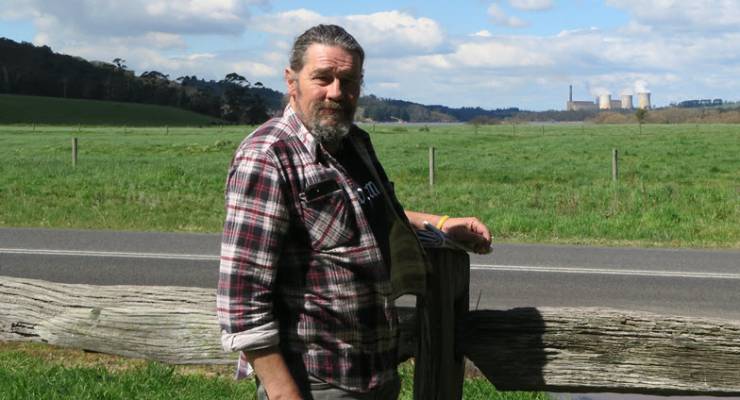
Ron Ipsen lives within full view of Yallourn W Power Station. It rests, past grazing cows, perched on the horizon in the faded yellows and greys of 1970s nation-building. Ron is quick to point out that the three smokestacks silently exhaling exhaust form a W, hence Yallourn W. He waits for three beats for his feint to sink in. “Nah, not really. It means Yallourn West.”
This is the heart of Victoria’s Latrobe Valley — brown coal country, 150km east of Melbourne. They say if you turn on a light in Fitzroy, you can be guaranteed the electricity was generated here. The question is: how will this electricity continue to be generated, both now and in the future? Ron, vice president of community group Voices of the Valley, is one of the many people trying to get answers.
Back inside Ron’s house, a giant corrugated iron workshop he calls “the shed”, he recounts an incident in 2015 when he claims to have “shirtfronted” visiting federal Green member Adam Bandt “about climbing the power stations”. “We don’t need that, mate. We’ve got a people here. Don’t shit on ‘em.” Ron notes that the Greens moderated their message after that. Coal was still bad but workers needed a way out. “There were no celebrations when Hazelwood closed.”

Nationally, the war over climate change has again frozen over but here, in the Valley, it runs hot. Ahead of the November 24 Victorian election, Premier Dan Andrews has promised six new renewable projects across regional areas while both Liberal and National candidates say a new coal-fired power station is needed in the Valley. Yet here, in the electorate of Morwell, a slew of independents have stepped up to take on the major parties. What unites them is a promise to create jobs; what divides them is what role coal will play in generating them.
Independent Ray Burgess stands on an unashamedly pro-coal platform, just like the Nationals. Yet Ray’s brand is more populist. “If you talk to locals about coal, for example, they’ll say to you ‘I don’t get why we can send coal to China, Japan and India and we can’t use our coal to help ourselves?’” he explains in the upstairs office of his Morwell newsagency.
For Ray, coal means lower power prices and jobs. Here with unemployment and other levels of social disadvantage amongst the highest in the state, these things matter. Ray references a report published in 2001 about disadvantage in the Valley. “You could cross out the 2001, you can put in 2018 and many of the metrics are still the same.”
True or not, the anxieties that Ray represents are visible as soon as you step outside and cross the tracks. The Latrobe Valley Hotel is closed for business, the tables still set in the gloomy interior, and the once bustling Church Street is picketed with For Lease signs past which lies a melange of undelivered mail and dust bunnies. As of April, unemployment in Morwell is holding at 15.6% but there are the glimmers of recovery. State Labor has poured in $266 million to the Latrobe Valley Authority in the wake of the closure of Hazelwood last year.
The current state of Morwell is more a legacy of ‘90s neoliberal economics than the Hazelwood closure. Before that, Victoria’s State Electricity Commission (SEC), ran what amounted to a quasi-socialist worker’s paradise. The paternal SEC did everything from turn out apprentices for the whole state to put on a yearly Christmas parade for workers’ families. Ron Ipsen noted wryly that it stood for “Slow Easy Comfortable — which it was — but it was also a Stable Economic Community”.
Privatisation began with Premier Joan Kirner, then continued with more vigour under Jeff Kennett. By the late 1990s, 7800 power industry jobs had been shed in the Valley alone and a house could be bought here for $16,000. With a third of young men unemployed, families that had enjoyed generations in the power industry suddenly found themselves either on welfare or resorting to fly-in-fly-out work.

Tracie Lund, another Independent, works from Morwell Neighbourhood House in the town’s poorer fringe. The surrounding houses are single storey, red brick with blinds drawn against the sun. Front yards grow tall, sometimes a car is on blocks or a mattress lies abandoned. Inside, she is directing deliveries for a food bank, next to a meeting room stocked with cans and jars.
Tracie rose to prominence running as an Independent for the 2014 election. This was on the back of the Hazelwood mine fire that burned for 45 days blanketing Morwell in smoke. It was the culmination of two decades of neglect by successive state governments and multinationals that seemed more concerned with protecting assets and image than workers and families.
“People were angry after the mine fire,” Tracie tells Crikey. Locals expressed themselves in that election, giving Tracie 10.9%, making the seat marginal. “People can push back and demand things now that they didn’t have the voice or opportunity to do so before. There is also an understanding that we have power.” She drops the pun with a wink.
“Politicians of all persuasions come in and out of this seat all the time. Across the nation, people are looking at this seat. We’ve got an industrial heartland that has to transition.”
The town of Traralgon is 13km down the M1 from Morwell but, economically, the divide is wider. The main drag is alive with shoppers and al fresco diners. Traralgon resident and Morwell Greens candidate Dan Caffrey laughs when I call him a besieged minority in the Valley. The local Greens has only eight members and are intensely disliked. Ray Burgess gleefully brandished a photocopied photograph taken when Hazelwood was shut — a banner is attached to a cyclone fence, written in black paint it says “Fuck the Greens”.
Dan concedes that they have had to moderate their platform, and parries that they have taken a “strong stance on the casualisation of the workforce” which should hold them in good stead with the locals. He remains adamant about wanting to end coal.
Back at “the shed” Ron stands beside a whiteboard pointing toward a scrawled diagram. “We tried to get the community to own the concept of transition. We wanted to make solar panels here. 50,000 panels would replace Hazelwood. We worked and worked and worked on that, but we hit the dichotomy. And you can only push so hard.” He sighs. The “dichotomy” is how Ron refers to community resistance to renewables borne from nostalgia for coal and mistrust of city politicians.
Things are changing, but slowly. “Just Transition” has become rallying cry for those wanting to cut the Gordian knot between jobs and emissions reduction. It is a phrase directly from the 2015 Paris Agreement and has gained currency here over the past few years. Labor candidate and local Mark Richards is calling for a “fair and just transition for workers”.
Outside, Ron stands back at the fence to look over Yallourn W again. “My father worked there and I worked there. I want to replace those three chimneys with wind turbines. I want to colour them black, yellow and red and call them “was, always, and will be”. He stubs out a cigarette and heads back to the shed.








Those smokestacks you’re talking about- those 3 squat towers that are ‘silently exhaling exhaust’ – are (evaporative/water) cooling towers, so what you see is steam rising..
Oh yawn, yet we know full well that its not merely steam that these power stations are emitting. Sulphur Dioxide, Carbon Dioxide, Nitrogen Dioxide, Mercury, Cadmium, Radon……& particulate emissions that cause heart & lung disease.
A common error, esp on TV reports – the need for something visual for people who move their lips when they think.
I once lived in the Valley, in a house built in the 1890s. There was fly ash and coal dust inches thick in the ceiling. One of the tricks was to turn the fly ash precipitators in the stacks off at night. Occasionally, when there was still sufficient light, you would see the difference in the smoke plume from the chimneys.
It is not “a new coal-fired power station [that] is needed in the Valley”, but a giant new steam-powered power station that is needed on the site of the old one.
It is only steam that can restore massive baseload to Victoria and South Australia, and contribute to baseload into NSW. The Latrobe site is a focus of the heavy duty power transmission grid needed for such a station. It also has water for condensing the steam. And obviously, it has a workforce that is looking for new jobs near their old homes.
The steam could be fired with either gas or nuclear, but none of the political parties have the moral spine needed to persuade the public that nuclear is necessary. It seems that the fossil fuel, methane, will win out again.
The point is that they have coal mines in the region, not gas or uranium.
Hence coal-fired.
The economics is against nuclear, gas and coal.
New plants will not produce power cheaper than could wind or solar.
And beyond the construction work, which would probably be done mostly by non-locals, I doubt a new plant would employ more people than are in the current plants.
Building a new coal power station would not help the local employment situation.
Just had a quick look at the size of the Yallourn open cut mine and found it has a depth of 200m. That could make it viable as a site for a pumped hydro system. If they could get the water to it.
Still pushing your Nuclear Power hobby-horse. So what do we all do in the 15+ years that it will take to construct one of your beloved nuclear power stations?
Also, what happens if-like France-we’re forced to shut down those nuclear reactors due to extreme heat?
Ah, Marcus, my sins are worse than that! Could I be implying that the windmill salesmen are purveyors of snake oil, praying on the honest fears of a credulous public, afraid for the climate of their grandchildren? Well yes, I am saying that intermittent wind can’t provide steady baseload power, it needs steam.
It didn’t have to be this way. There was a time when Australia was a world leader in renewable energy. A planned, government-supported transition to a new economic base for the region could have avoided all the suffering and indignity that the region’s workforce has been forced to endure. After all, the government invested hundreds of millions of dollars over decades, propping up multinational automobile manufacturers. Would it have made any less sense to pour the same funding into a local, state-owned industry that wouldn’t just pocket the money and run eventually anyway?
This “dichotomy” – parochialism, poverty & poor understanding – is the nub of the problem for progressive politics, whether the debate is power generation, farming or deindustrialisation.
The past is more comforting to many people the future, never mind that they were royally screwed in the bad. old daze.
A shame no one seems to have any plans for cities that aren’t Sydney, Melbourne etc. This keeps happening and the powers that be don’t even bother to fix it. It would be a lot easier to sell The Future if one were on offer. Sometimes I wonder if they’ll just do all the regional towns and cities like those WA remote Indigenous communities. “Too hard, move to somewhere with jobs I guess? Well, cya.”
Too right Draco. Why wasn’t something done years ago rather than making promises now for the next elections. Why let it get this bad. Meanwhile families are disrupted, commuting for work, bills cant get paid.